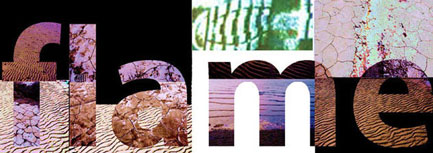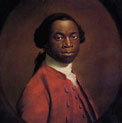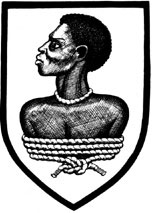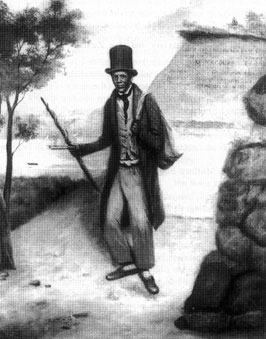

Co-editors: Seán Mac Mathúna • John Heathcote
Consulting editor: Themistocles Hoetis
Field Correspondent: Allen Houglande-mail: thefantompowa@fantompowa.org
Olaudah
Equiano or Gustavas Vassa, the African slave - a short
biography
In London, one thing most
school children are still not taught much about, is the
depth of England's involvement with the slave trade and the
simple fact - as pointed out by many historians - that the
wealth generated by this barbaric practice generated the
wealth that created the industrial revolution in England -
and lined the pockets of the aristocracy and the City of
London. The National Gallery in London was founded on it,
Lloyd's of London and the Bank of England were immersed in
it . According to One Foot in the Past, a programme
shown on BBC TV in 1993, involvement in the slave trade was
seen as a respectable occupation in London during the 17th
and 18th centuries. Although Bristol and Liverpool were the
main docking areas for slaves coming into England, (hence
the opening of the first US diplomatic mission in Bristol),
it was in London that businessmen who made millions from the
financing of the slave trade. By 1750, it was these London
merchants which were taking almost three-quarters of the
sugar imported from the West Indies, and many of them lived
in South London, in a area thought today - as it was
yesterday - as quite respectable
- Blackheath. Thus, many famous institutions
in London were built on the profits of the slave trade,
according to research carried out by Dr Nick Merriman of the
Museum of London. (1) These included Barclays Bank, founded
by Alexander and David Barclay, who were among 84 Quaker
slave traders operating in the West Indies according to the
records of the Society of Friends. (1) One bank closely
connected with slavery and South East London was Barings
Bank. It's founder, Sir Francis Baring earned nearly £7
million from a business of dealing in slaves that went back
70 years. Baring Road in South East London is named after
him. He was said to have his first money trading in slaves
when he was just 16, indicating his family's immense wealth
and business connections with the West Indies. Thus, it is
an outrage that this road (in the London Borough of
Lewisham), has not been renamed. The founding collection of
pictures at the National Gallery in London, was given by
John Julius Angerstein. He had built up his art collection
with the money made from the slave trade, and his activities
as one of Lloyd's underwriters insuring the slavers.
According to one historian, the Bank of England should well
have been called the Bank of the West Indies, because of
it's involvement in slavery. Humphrey Morice, the Bank's
governor between 1716 and 1729, owned six slave ships. Sir
Richard Neave, a director for 48 years, was chairman of the
Society of West Indian Merchants. Slaves were sold on the
London Royal Exchange and "other places of public resort" -
many of them children. Joan Anim-Addo in her book
Longest Journey: A History of Black Lewisham, has
been the only author to write a definitive account of the
long history and struggle of the black population in South
East London. Here we read that the earliest contact of
Africans with South east London, would have been at least
2000 years ago. The evidence is in a miniature carved wooden
figure with distinctive African features and design that was
found near Southwark Bridge in London. Within the ranks of the Roman
Legions that were garrisoned across Britain were African
soldiers - at least 500 were thought to be stationed in a
garrison near Carlise for example. They would have probably
travelled along Watling Street through Deptford - the Roman
road that ran from Dover to Chester. Thus, the first Africans that
forded the creek at Deptford, would have been those serving
with the Roman army. However, the next significant presence
of Africans in the Deptford/Greenwich area would come during
Elizabethan times - at a time when the area developed in
strong links with the slave trade.(2) The Royal Dockyard at Deptford
played a significant role in the slave trade. In 1553, The
Primrose, a ship built at Deptford two years earlier, would
provide the first contact between the English and African
Kingdom of Benin. The journey was a business enterprise that
involved the young adventurer, Martin Frobisher. Although he
is known for his voyages to the Artic and China (from which
he was seen off from Deptford by Elizabeth I in 1576), he
spent his early years sailing around the coast of West
Africa involved in the slave trade. No doubt, that was were
he made his money to finance such trips. The first recorded instance of
African slaves in Deptford was on 9th November 1501 when
Catherine of Aragon arrived in Deptford with two slaves from
Spain to marry Henry VII's eldest son, Arthur. By 1530,
English seamen begin to challenge the dominance of Spain and
Portugal with exclusive rights to trade in Africa. Foremost
among these was William Hawkins, father of John Hawkins, the
notorious slave trader. Between 1530 and 1537, made at
least three journeys to Guinea where he traded in ivory and
other rare goods. Soon, the main trade would be of two
things; gold and slaves, and Deptford and London would play
a major role in this through their docks. (3) Deptford became a centre for
those interested and involved in the slave trade and its
business in the Caribbean. A key figure in the slave trade
was a resident of Deptford and pirate, Sir John Hawkins. The
Church of St. Nicholas contains a statue of William Hawkins,
his brother, which was erected by Hawkins, then Treasurer of
the Royal Navy in 1589. Described as "the English father of
the slave trade", he lived in the Treasurers House at
Deptford Dockyard and made his first slaving trip from
England in 1562.(4) In the The Open Veins of
Latin America, Eduardo Galerno describes how Elizabeth 1
became a business partner of Captain John Hawkins.(5) His
first slave expedition in 1562 was made with a fleet of
three ships and 100 men. He smuggled 300 slaves out of
Portuguese Guinea "partly by the sworde, and partly by other
meanes". According to James Walvin
writing in Black Ivory, Hawkins sold the slaves in
Hispaniola, and filled his ships with "hides, ginger,
sugars, and some quantities of pearles". A year after
leaving England, Hawkins returned to England "with properous
successe and much gaine to himself and the aforesayde
adventurers".(6) According to Galerno, when
Elizabeth I found out, she was furious: "it was detestable
and would call down vengeance from heaven upon the
undertakers", she cried. But, when Hawkins told her that in
exchange for the slaves, he had a cargo of sugar, ginger,
hides and pearls, "she forgave the pirate, and became his
business partner". 25 She supported him by loaning him for a
second expedition, The Jesus of Lubeck, a 700 ton vessel
purchased for Henry VIII for the Royal Navy. Anim-Addo notes from the
official Navy records how the slave trade was to "enrich
England for centuries to come . . . and correspondingly
depopulate and impoverish Africa": As business increased, and he
made himself rich, Hawkins reputation soared within slaving
circles. On his third slaving expedition in 1567, for which
Elizabeth's I's investment increased to two ships, he was
accompanied by Sir Francis Drake. On this particular journey
they "had obtained between four and five hundred Negroes,
wherewith we thought it somewhat reasonable to seek the
coast of the West Indies".(7) Along with Hawkins, Drake was
another pioneer of the English slave trade. His family was
well connected with slavery and with Deptford. In 1585, he
had appointed to command an expedition to the Caribbean that
marked the beginning of open war with Spain. However, the
Queen of England thought that Drake's "low birth" and
independent temperament made him unfit to command her fleet
against the Spanish Armada in 1588, and he ceded control to
another Deptford resident, Charles Howard of Effingham.
Drake died at sea with Hawkins of the coast of Panama in
1596. Another of Deptford's famous
slave traders was Sir Walter Raleigh who had business
connections with both Hawkins and Frobisher. He was the
great grandson of Baron Edmund Carew of the Carew family of
Blackheath. In 1595, he led four ships on the search seeking
El Dorado or Golden Land of Guiana. Howard contributed one
of his ships The Lion's Whelp. The journey however, was not
a great success, and Raleigh returned home with gold samples
whose authenticity was doubted. Jailed later in the Tower of
London, he was released in 1616 to organise another trip in
search of the legendary gold of El Dorado. A ship, The
Destiny was built in Deptford and he sailed for Guiana where
he lost his son in battle with the Spanish. Devastated, he
returned to England. He was later arrested after a chase in
the River Thames when he entrusted his escape plans to the
wrong party. He was tried in closed court and executed in
1618.(7) The connections between the
royal family and slavery continued: the Duke of York was
branding the initials "DY" on the left buttock or breast of
each of the 3000 slaves his "business concern" shipped to
what were called the "sugar islands" in the
Caribbean. Later, Charles II was a
shareholder in the Royal African Company, which made vast
profits from the slave trade. Of the 70,000 slaves the
company shipped to the Caribbean between 1680 and 1688, only
46,000 survived the crossing of the Atlantic Ocean. On these
voyages of death, many Africans died of epidemics of disease
or malnutrition - many simply committed suicide by either
refusing food, hanging themselves by their chains, or
throwing themselves overboard into a sea bristling with
sharks fins.(7) Before the British seizure of
Australia in 1788, English political dissenters and
criminals were deported to America and the West Indies.
After the American War of Independence these people were
transported to Australia, including hundreds of black people
and thousands of Irish and Scots dissidents. The most famous
English prisoners were the Tolpuddle martyrs who were
deported to Australia because of their determination to set
up a trade union. John Ceasar and Billy Blue,
both of whom lived in Deptford, were among the earliest
prisoners to be deported. Caesar, described as a "powerfully
built Negro" was convicted as Maidstone in 1785, and held on
a prison boat on the Thames until the fleet sailed for
Botany Bay in Ireland in 1787. Maidstone jail was also where
the priest and liberation theologian John Ball was
held. On arrival in Australia, Caesar
was sent to labour in chains on Garden island in Sydney
harbour. However, he managed to escape in April 1789 with a
musket, some rations, and a iron cooking pot. He survived
for 19 days by stealing from the settlements on the
mainland. When he was caught, he was returned to Garden
Island, but he escaped again &endash; after stealing a boat
from the local Aborigines. After a month, he was caught and
banished to Norfolk Island. Five years later, he fled again,
and in January 1796 a reward of five gallons of rum was
offered for his capture. In February, he was ambushed and
shot dead by Bounty hunters in a place known ironically as
Liberty Plains. As for Billy Blue, the little
we know about his life comes from a petition he sent to a
Governor Brisbane in 1823 when he 89 years old. He had
served as a soldier in the British army and was involved in
the attack on Quebec in 1759. During the American War of
Independence, Blue was a "spy or guide" for the army, which
Anim-Addo thinks may indicate that he had American Indian
ancestry. He had been a "lumper" at Deptford Dockyard, and
in 1796, he was convicted of stealing sugar from a West
Indian owned ship, the Lady Jane Halliday. He was said to
have had his own chocolate making business, and as a result
ended up spending nearly 5 years on prison hulks on the
River Thames before transportation to
Australia.(2) However, his ended up being
appointed a Watchman at Sydney Cove, and was granted 80
acres of land to the north of the harbour, known today as
Blue's Point. In 1818, he was convicted of smuggling rum,
but was pardoned because of his "special relationship" with
the British colonial administration. He died in 1834,
leaving his property to his children. I found most of the information
on the British royal families involvement in the slave trade
in the
excellent book by Hugh Thomas The Slave Trade: The
History of the Atlantic Slave Trade 1440-1870 (Picador,
London, UK, 1997). In it, he shows how in
1632, King Charles I first granted a licence to transport
slaves from Guinea. In 1651, a new Guinea Company in London
was founded, in which a prominent London merchant and slave
trader Samuel Vassall was one of the major shareholders.
Vassall was one of the early 'incorporators' of
Massachusetts. He also collaborated with Lord Berkeley to
develop Virginia. Vassall had had endless debts and
lawsuits, and several terms of imprisonment. An MP, for the
City of London, he was also a commissioner concerned in the
establishment of the Providence plantations in Narragansett
Bay. As Thomas notes, the end of the monarchy of Charles I,
and the coming of a Puritan administration, had had no
effect on the City of London's desire to make money from
slaves; nor did the change in the regime after the
Restoration of 1660 alter that ambition. This company
however did not prosper, as its ships were attacked at sea
by the Royalist Prince Rupert, then leading a "piratical
monarchist fleet" to the West Indies in alliance with the
Portuguese. They were also attacked by the buccaneer Captain
Carloff and his Danes. The losses of the company are
estimated to have reached £300,000. Despite this,
it was during this time that the trading of slaves by
London-based ships began on a regular basis. According to
Thomas, one instruction of 1651 by the Guinea Company had
asked a captain of one of their ships that he bring back to
England 'fifteen or twenty lusty negers'. Another asked a
captain on a ship said to be bound for London to 'put aboard
. . . so many negers as your ship can carry'. London slave
merchants were also involved in sending slaves to Barbados,
as yet a third letter requested: Members of the
British royal family were the first members of a European
royal family to go to West Africa - and purpose of the visit
was slavery. In 1660, after the Restoration of Charles II, a
new slave-trading company was set up in London called the
Royal Adventurers into Africa. The unemployed Duke of York,
the brother of King Charles II was the President of the new
company which was given a monopoly of the English African
trade for 1,000 years. Princess Henrietta ('Minette'), the
King's sister, also had a share Investors, who
were known as "The Royal Adventurers", each of invested
£250 in the enterprise, and included most of the
important politicians of the time: for example, the King's
friend the Duke of Buckingham, Lord Craven, Lord Ashley, the
Duke of Albermarle (General Monck), Lord Arlington, Lord
Berkeley, Lord Crofts, Henry Jermyn (a prominent Catholic),
and Lord Sandwich, the admiral who had brought back King
Charles II from exile in Holland. The King's brother, the
unemployed Duke of York, became President. In total, there
were four members of the royal family, two dukes, a
marquess, five earls, four barons, and seven
knights. When a new
charter was issued for the company of Adventurers in January
1663, shareholders now included King Charles II, the Queen
Mother, Henrietta Maria, and the Duke of York (who invested
£2,000). Other included new Queen, Catherine of
Braganza (whose dowry of £330,000 was partly financed
slave traders), and Samuel Pepys. The, so-called
"philosopher of liberty", John Locke was another subscriber.
As noted by Thomas: Thus, as Thomas
observes, the commitment by the royal family to the African
slave trade was strong. Few people know the origin of the
money once used in England called "guineas" - but it will
come as no surprise to know that the coin was named after a
country in West Africa where the British were heavily - and
profitably - involved in the slave trade. In 1663, it was
agreed that some of the gold brought back from the Gold
Coast region (present day Ghana to Guinea) should be turned
by the Royal Mint into coins with an elephant on one side.
Because of there connection to the slave trade, Thomas
points out, they "were popularly called 'guineas' from the
beginning". The coin was made until 1813, and the unit of
currency continued in use till the abolition of the old
shilling in 1967. In 1665 the
company of Adventurers estimated its annual return from gold
as £200,000, from slaves as £100,000, and from
ivory, wax, hides, woods, grain (pepper) as another
£100,000. It had had assured the King that: The Royal
Adventurers company was wound up in 1672 and in its place,
the Royal African Company (RAC)
founded. The
Governor and largest shareholder, was James, Duke of York.
The directors also included four proprietors of plantations
in Carolina (Lord Shaftesbury, Lord Craven, Sir George
Carteret, Commissioner for Trade and Plantations; and Sir
John Colleton, a landowner in Barbados as well as Carolina)
- as well as Lord Berkeley, "the first peer . . . to collect
directorships". The shareholders also included over the
years, fifteen of the lord mayors of London, twenty-five
sheriffs of London, and again, John Locke.
Between 1672 and 1689, the
company exported just under 90,000 slaves into the West
Indies. A further 75,000 slaves were sent to British North
America, and sold onto plantations in the 13 colonies,
between 1673 and 1725, according to Thomas. Thus it is
clear that much of London's early wealth was generated by
the Slave trade, with the involvement of many prominent
people at the time - from John Locke to Samuel Pepys, most
of the merchants in the City of London seemed to have a hand
in it, along with the involvement of the British royal
family from the 16th century to the 18th century. 1 Evening Standard, 24th
June 1993.

Slavery is as the heart of the wealth of London" -
Geraint Smith, 1993 (1)
A
feature of the shipping engaged in West Indian
privateering which may cause some surprise is the
overwhelming predominance of Londoners. There are
forty-one ships mentioned herein whose port of origin
has been traced; thirty-one were from London.
Kenneth Andrews
South East London
The man of the
fleet were kept busy going ashore every day to capture
the Negroes, burning and spoiling their towns, and many
were taken . . . by the 21st December, the raiding
parties had taken all the Negroes they could find and had
also carried on board as much fruit . . .(7)

What about the
life of black slaves in South East London ? Hardly any
accounts survive, but Joan Anim-Addo gives brief
descriptions of two such slaves: John Caesar and Billy
Blue (see picture above). (1) She describes how Caesar
was one of many black slaves who ended up in London, who
was to pay a steep price for gaining a criminal record.
The British
royal family and slavery
'We
pray you buy as many lusty negers as she well can carry,
and so despatch her to the Barbados'.
"The
profits which could be made from trading slaves had by
then been appreciated in England."
"The
very being of the plantations depends upon the supply of
negro servants for their works" Hugh Thomas in The
Slave Trade: The History of the Atlantic Slave Trade
1440-1870 (Picador, London, UK, 1997)
REFERENCES
2 Longest Journey: A History of Black Lewisham, Joan
Anim-Addo. Deptford Forum Publishing Ltd, London, UK, 1995,
Idid, pp1-2.
3 Longest Journey: A History of Black Lewisham, Idid,
pp4-9.
4 The Open Veins of Latin America: Five Centuries of the
Pillage of a continent, Eduardo Galerno, Monthly Review
Press, NY, USA, 1973, Pp 92-93
5 Black Ivory: A History of British Slavery, Fontana
Press, London, UK, p25.
6 Longest Journey: A History of Black Lewisham, ibid,
pp8-11.
7 Longest Journey: A History of Black Lewisham, ibid,
pp29-33.
8 The
Slave Trade: The History of the Atlantic Slave Trade
1440-1870. Hugh Thomas, Picador, London, UK,
1997.